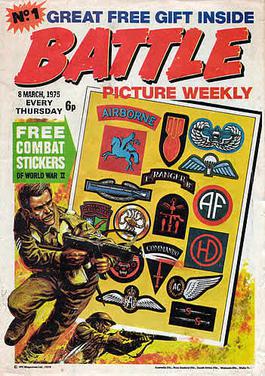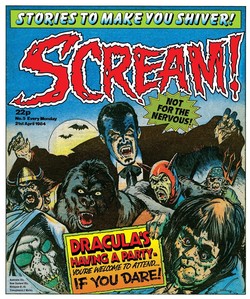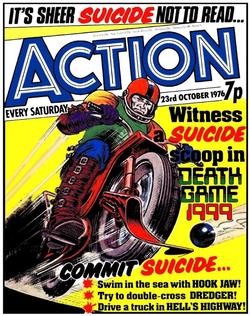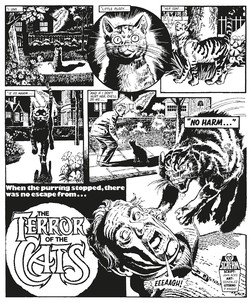
2000 AD is a weekly British science fiction-oriented comic magazine. As a comics anthology it serialises stories in each issue and was first published by IPC Magazines in 1977, the first issue dated 26 February. Since 2000 it has been published by Rebellion Developments.

John Wagner is an American-born British comics writer. Alongside Pat Mills, he helped revitalise British comics in the 1970s, and continues to be active in the British comics industry, occasionally also working in American comics. He is the co-creator, with artist Carlos Ezquerra, of the character Judge Dredd.

Crisis was a British comic anthology published by Fleetway Publications from 17 September 1988 to October 1991, initially fortnightly and later monthly. Designed to appeal to older readers than other Fleetway titles in order to take advantage of a boom in interest in 'adult' comics, Crisis featured overtly political and complex stories; one issue was even produced in conjunction with Amnesty International.

Battle Picture Weekly was a British weekly boys' war comic published by IPC Magazines from 8 March 1975 to 23 January 1988, when it merged with the new incarnation of Eagle after 644 issues. Most stories were set in World War II, with some based on other conflicts, while factual features also focused on warfare.

Action was a British weekly boys' comic published by IPC Magazines from 14 February 1976 to 5 November 1977, when it merged with war comic Battle after 86 issues. The comic was created by Pat Mills and Geoff Kemp.

Scream! was a weekly British comics periodical published by IPC Magazines from 24 March to 30 June 1984. A horror comic anthology comic, the title lasted for 15 editions before being merged with another title, Eagle.

Starlord was a British weekly boys' science fiction comic published by IPC Magazines from 13 May to 7 October 1978, when it merged with 2000 AD after 22 issues. The comic was created by Kelvin Gosnell, and was originally intended as a fortnightly sister title for 2000 AD with higher production values and an older audience, but late changes in production saw it converted into a weekly.

Tornado was a British weekly boys' adventure comic published by IPC Magazines from 24 March to 18 August 1979. The comic was partly created as a way to use up stories already commissioned for the other titles, and was marred by a difficult production. Tornado sold poorly and was merged with 2000 AD after 22 issues.
Steve MacManus is a British comic writer and editor, particularly known for his work at 2000 AD.

"Hook Jaw" is a British comic adventure story published in the weekly anthology Action from 14 February to 12 November 1977 by IPC Magazines.

"Hellman of Hammer Force" is a British comic strip published by IPC Magazines in the boys' comic anthology titles Action and later Battle between 14 February 1976 and 8 July 1978. The story was set in World War II; while war comics were common material in British comics of the time, "Hellman of Hammer Force" was rare for its use of a sympathetic Wehrmacht officer as the lead protagonist. While not as controversial as fellow Action stories such as "Kids Rule O.K." and "Hookjaw" it was nevertheless caught up in the campaign against the title by the British tabloid press.

"D-Day Dawson" is a British comic war story published in the weekly anthology Battle Picture Weekly from 8 March 1975 to 22 January 1977 by IPC Magazines. Set during World War II, the story follows Steve Dawson, a sergeant in the British Army left with an inoperable bullet next to his heart after being shot during the D-Day landings.

"The Bootneck Boy" is a British comic war story published in the weekly anthology Battle Picture Weekly from 8 March 1975 to 12 November 1977 by IPC Magazines. Set during World War II, the story follows Danny Budd, a youth from the fictional Northern England town of Tynecastle as he strives to join the Royal Marines.

"Rat Pack" is a British comic war story published in the weekly anthology Battle Picture Weekly from 8 March 1975 to 8 July 1978 by IPC Magazines. Set during World War II, the story follows the eponymous unit, compromised of a penal military unit of four criminals recruited by British Army officer Major Taggart to undertake deadly missions.

"Death Game 1999" is a British comic science fiction/sport story published in the weekly anthologies Action and Battle Action from 8 May 1976 to 3 November 1979 by IPC Magazines.

"Kids Rule O.K." is a British comic science fiction adventure story published in the weekly anthology Action from 11 September to 16 October 1976 by IPC Magazines.

Eagle, sometimes referred to as The New Eagle and known at various points in its life as Eagle and Scream!, Eagle and Tiger, Eagle and Battle, Eagle and M.A.S.K. and Eagle and Wildcat, was a British boys' adventure comic published by IPC Magazines from 27 March 1982 to January 1994. A revival of the famous Eagle, the title was initially a weekly publication until turning into a monthly in May 1991. The title was finally cancelled in January 1994, after 505 issues.

"Terror of the Cats" is a British horror comic strip character, appearing in titles published by IPC Magazines. The strip was published in the weekly anthology Scream! from 24 March to 28 April 1984. The story was initially written by Chris Lowder before he quit, with Simon Furman taking over; it was Furman's first published comics work. José Gonzalez and John Richardson provided artwork. The story concerns housecats suddenly becoming hostile to humans.

"The Nightcomers" is a British science fiction strip character, appearing in titles published by IPC Magazines. The strip debuted in the weekly anthology Scream! on 5 May 1984, running until the comic was cancelled after the 30 June 1984 edition. The story was written by Tom Tully and drawn by John Richardson.


















